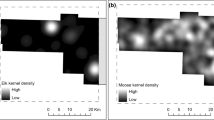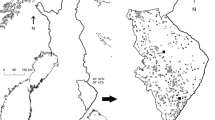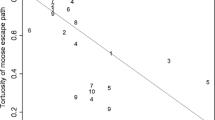Abstract
Over 6,000 GPS fixes from two wolves (Canis lupus) and 30,000 GPS fixes from five moose (Alces alces) in a wolf territory in southern Scandinavia were used to assess the static and dynamic interactions between predator and prey individuals. Our results showed that wolves were closer to some of the moose when inside their home ranges than expected if they had moved independently of each other, and we also found a higher number of close encounters (<500 m) than expected. This suggests that the wolves were actively seeking the individual moose within their territory. Furthermore, the wolves showed a preference for moving on gravel forest roads, which may be used as convenient travel routes when patrolling the territory and seeking areas where the moose are. However, due to the particularly large size of the wolf territory combined with relatively high moose densities, the wolves generally spent a very small proportion of their time inside the home range of each individual moose, and the frequency of encounters between the wolves and any particular moose was very low. We suggest that the high moose:wolf ratio in this large Scandinavian wolf territory compared to that typically occurring in North America, results in a relatively low encounter frequency and a low predation risk for individual moose, as the predation pressure is spread over a high number of prey individuals.





Similar content being viewed by others
References
Alfredéen A-C (2006) Denning behaviour and movement pattern during summer of wolves Canis lupus on the Scandinavian Peninsula. MSc Thesis, Department of Conservation Biology, Swedish University of Agricultural Sciences, Uppsala
Andreassen HP, Gundersen H, Storaas T (2005) The effect of scent-marking, forest clearing, and supplemental feeding on moose–train collisions. J Wildl Manage 69:1125–1132
Arnemo JM (ed) (2006) Biomedical protocols for free-ranging brown bears, gray wolves, wolverines and lynx. Norwegian School of Veterinary Science, Tromsø
Arnemo JM, Kreeger TJ, Soveri T (2003) Chemical immobilization of free-ranging moose. Alces 39:243–253
Berger J (2007) Fear, human shields and the redistribution of prey and predators in protected areas. Biol Lett doi:10.1098/rsbl.2007.0415
Berger J, Swenson JE, Persson I (2001) Re-colonising and naïve prey: conservation lessons from Pleistocene extinctions. Science 291:1036–1039
Bowman JL, Kochanny CO, Demarais S, Leopold BD (2000) Evaluation of a GPS collar for white-tailed deer. Wildl Soc Bull 28:141–145
Edwards J (1983) Diet shifts in moose due to predator avoidance. Oecologia 60:185–189
Gillies CS, Hebblewhite M, Nielsen SE, Krawchuck MA, Aldridge CL, Frair JL, Saher DJ, Stevens CE, Jerde CL (2006) Application of random effects to the study of resource selection by animals. J Anim Ecol 75:887–898
Gundersen H (2003) Vehicle collisions and wolf predation: Challenges in the management of a migrating moose population in southeast Norway. PhD Thesis, University of Oslo, Norway
Gundersen H, Andreassen HP, Storaas T (2004) Supplemental feeding of a migratory moose: forest damages at two spatial scales. Wildl Biol 10:213–223
Gundersen H, Solberg E, Wabakken P, Storaas T, Zimmermann B, Andreassen HP (2008) Three approaches to estimate wolf Canis lupus predation rates on moose Alces alces populations. Eur J Wildl Res (in press)
Hamre Ø (2006) Spatial and temporal use of forest roads by wolves in Scandinavia during summer. MSc Thesis, Faculty of Science, Department of Biology, University of Tromsø
Harrington FH, Mech LD (1982) Patterns of homesite attendance in two Minnesotan wolf packs. In: Harrington FH, Paquet PC (eds) Wolves of the world: perspectives of behaviour, ecology, and conservation. Noyes Publications, Park Ridge, pp 81–105
Johansson K (2002) Wolf territories in Scandinavia; sizes, variability and their relation to prey density. MSc Thesis, Department of Conservation Biology, Swedish University of Agricultural Sciences, Uppsala, Sweden
Kernohan BJ, Gitzen RA, Millspaugh JJ (2001) Analysis of animal space use and movements. In: Millspaugh JJ, Marzluff JM (eds) Radio tracking and animal populations. Academic Press, San Diego, pp 125–166
Liberg O, Andrén H, Pedersen HC, Sand H, Sejberg D, Wabakken P, Åkesson M, Bensch S (2005) Severe inbreeding depression in a wild wolf (Canis lupus) population. Biol Lett 1:17–20
Laundré J, Hernández WL, Altendorf KB (2001) Wolves, elk, and bison: reestablishing the “landscape of fear” in Yellowstone National Park, USA. Can J Zool 79:1401–1409
Mech LD (1966) The wolves of Isle Royale. U.S. National Park Service Scientific Fauna Series. No 7
Manly BFJ, McDonald LL, Thomas DL, McDonald TL, Erickson WP (2002) Resource selection by animals: Statistical analysis and design for filed studies, 2nd edn. Kluwer, Boston
Mech LD (1970) The wolf: the ecology and behaviour of an endangered species. University of Minnesota Press, Minneapolis
Mech LD (1977) Wolf-pack buffer zones as prey reservoirs. Sci New Series 198:320–321
Mech LD, Meier TJ, Burch JW, Adams LG (1995) Patterns of prey selection by wolves in Denali National Park, Alaska. In: Carbyn LD, Fritts SH, Seip DR (eds) Ecology and conservation of wolves in a changing world. Canadian Circumpolar Institute, Edmonton, pp 231–244
Messier FC, Crête M (1985) Moose–wolf dynamics and the natural regulation of moose populations. Oecologia 65:503–512
Milner JM, Nilsen EB, Wabakken P, Storaas T (2005) Hunting moose or keeping sheep?—producing meat in areas with carnivores. Alces 41:49–61
Nilsen EB, Pettersen TB, Gundersen H, Milner JM, Mysterud A, Solberg EJ, Andreassen HP, Stenseth NS (2005) Moose harvesting strategies in the presence of wolves. J Appl Ecol 42:389–399
Palm D (2001) Prey selection, kill and consumption rates of moose by wolves in central Sweden. Comparison to moose population and human harvest. MSc Thesis, Department of Conservation Biology, Swedish University of Agricultural Sciences, Uppsala, Sweden
Pedersen HC, Brainerd SM, Liberg O, Sand H, Wabakken P (2003) Wolf-population dynamics, viability and effects of alpha-individual loss. NINA Fagrapport no 61. In Norwegian with English summary
Pedersen HC, Wabakken P, Arnemo JM, Brainerd SM, Brøseth H, Gundersen H, Hjeljord O, Liberg O, Sand H, Solberg EJ, Storaas T, Strømseth TH, Wam H, Zimmermann B (2005) Carnivores and Society (RoSa). The Scandinavian wolf research project SKANDULV. Activities carried out during 2000–2004. NINA Report no. 117. In Norwegian with English summary
Peters RP, Mech LD (1975) Scent marking in wolves: a field study. Am Sci 63:628–637
Peterson RO (1977) Wolf ecology and prey relationships on Isle Royale. U.S. National Park Service Scientific Monograph Series. No. 11
Peterson RO, Vucetich JA (2005) Ecological studies of wolves on Isle Royale. Annual report 2004–2005. School of Forest Resources and Environmental Science, Michigan Technological University, Houghton, Michigan
Poole KG (1995) Spatial organization of a lynx population. Can J Zool 73:632–641
Rodgers AR (2001) Tracking animals with GPS: the first ten years. In: Sibbald AM, Gordon IJ (eds) Proceedings of the international conference tracking animals with GPS, Aberdeen, pp 1–10
Sand H, Liberg O, Aronson Å, Pedersen HC, Wabakken P, Brainerd S, Karlsson J, Ahlqvist P (2007) Vargen—Artfakta: en sammanställning av data från det skandinaviska vargforskningsprojektet SKANDULV 2007 på uppdrag av utredningen om de stora rovdjuren (in Swedish). Rapport Grimsö forskningsstation, SLU, 75 pp
Sand H, Wabakken P, Zimmermann B, Johansson Ö, Pedersen HC, Liberg O (2008) Summer kill rates and predation pattern in a wolf-moose system: can we rely on winter estimates? Oecologia. doi:10.1007/s00442-008-0969-2
Sand H, Wikenros C, Wabakken P, Liberg O (2006a) Cross-continental differences in patterns of predation: will naive moose in Scandinavia ever learn? Proc R Soc B 273:1421–1427
Sand H, Wikenros C, Wabakken P, Liberg O (2006b) Effects of hunting group size, snow depth and age on the success of wolves hunting moose. Anim Behav 72:781–789
Sand H, Zimmermann B, Wabakken P, Andrèn H, Pedersen HC (2005) Using GPS technology and GIS cluster analyses to estimate kill rates in wolf-ungulate ecosystems. Wildl Soc Bull 33:914–925
Stephens PW, Peterson RO (1984) Wolf-avoidance strategies of moose. Hol Ecol 7:239–244
Storaas T, Nicolaysen KB, Gundersen H, Zimmermann B (2005) Project moose-traffic in Stor-Elvdal 2000–2004—how to avoid moose-vehicle accidents on roads and railway lines. Hedmark University College. Report on commission no 1. In Norwegian with English summary
Theuerkauf J, Jędrzejewski W, Schmidt K, Okarma H, Ruczyński I, Śnieżko S, Gula R (2003) Daily pattern and duration of wolf activity in the Białowieża forest, Poland. J Mamm 84:243–253
Thurber JM, Peterson RO (1993) Effects of population density and pack size on the foraging ecology of gray wolves. J Mamm 74:879–889
Vucetich JA, Peterson RO (2006) The wolves and moose of Isle Royale. Accessed 10 July 2006 at: http://www.isleroyalewolf.org/index.htm
Wabakken P, Sand H, Liberg O, Bjärvall A (2001) The recovery, distribution, and population dynamics of wolves on the Scandinavian Peninsula, 1978–1998. Can J Zool 79:710–725
Wabakken P, Aronson Å, Sand H, Strømseth TH, Kojola I (2004) The wolf in Scandinavia: Status report of the 2003–2004 winter. Hedmark University College. Report on commission no 5. In Norwegian with English summary
Wabakken P, Aronson Å, Strømseth TH, Sand H, Kojola I (2005) The wolf in Scandinavia: Status report of the 2004–2005 winter. Hedmark University College. Report on commission no 6. In Norwegian with English summary
Worton BJ (1987) A review of models of home range for animal movement. Ecol Model 38:277–298
Zimmermann B, Storaas T, Wabakken P, Nicolaysen K, Steinset OK, Dötterer M, Gundersen H, Andreassen HP (2001) GPS collars with remote download facilities, for studying the economics of moose hunting and moose–wolf interactions. In: Sibbald AM, Gordon IJ (eds) Proceedings of the international conference tracking animals with GPS, Aberdeen, pp 33–38
Acknowledgments
We are grateful to M. Dötterer, F. Holen, E. Mømb, E. Nystedt, E. Strætkvern, and T. H. Strømseth for assistance in fieldwork, and to two anonymous referees for useful comments on the manuscript. This study was supported by the Norwegian Directorate for Nature Management, the Norwegian Research Council, the Norwegian Institute for Nature Research, Hedmark University College, the County Governor of Hedmark, the Stor-Elvdal municipality, the Swedish Environmental Protection Agency, the Association for Hunting and Wildlife Management (Sweden), the World Wildlife Fund for Nature (Sweden), and the Swedish University of Agricultural Sciences. All captures, handling, and collaring of animals were made with permission from the national management authority, the Directorate for Nature Management, and evaluated and approved by the Norwegian Agency of Animal Welfare (Application: 3/2002, 1/2004, Forsøksdyrutvalget, Ministry of Agriculture, Oslo, Norway).
Author information
Authors and Affiliations
Corresponding author
About this article
Cite this article
Eriksen, A., Wabakken, P., Zimmermann, B. et al. Encounter frequencies between GPS-collared wolves (Canis lupus) and moose (Alces alces) in a Scandinavian wolf territory. Ecol Res 24, 547–557 (2009). https://doi.org/10.1007/s11284-008-0525-x
Received:
Accepted:
Published:
Issue Date:
DOI: https://doi.org/10.1007/s11284-008-0525-x




